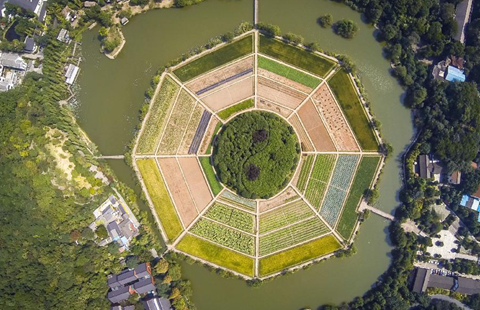Lyrics of the relics
Updated: 2015-04-14 08:49
By Wang Kaihao(China Daily)
|
||||||||
Recent archeological discoveries in China may lead to fresh look at Silk Road history. Wang Kaihao reports.
Many archeological discoveries in China last year have shed a new light on the history of the Silk Road and have the potential to trigger the rewriting of textbooks.
Hundreds of years ago, Chinese traders used overland and marine routes to trade silk and porcelain.
In 2014, the discovery of a major porcelain kiln in coastal Zhejiang province's Shangyu city suggested the Maritime Silk Road, which is generally considered to have reached its peak during the Song Dynasty (960-1279), could actually have developed earlier - in the Eastern Han Dynasty (AD 25-220).
Liu Qingzhu, academic director for the Institute of Archeology, affiliated to think-tank Chinese Academy of Social Sciences, is among the experts who believe this was the case.
The Shangyu site is on the 2014 Top 10 archeological discoveries' list that was unveiled by the State Administration of Cultural Heritage last week in Beijing.
"The world has talked about Chinese porcelain for centuries, but where it was born? Discovery of the celadon kiln offers important clues," Liu tells China Daily. "It could be a possible origin for China's mature ceramics industry."
Since 1990, China Cultural Relics News, an arm of the above administration, has organized an annual poll, dubbed by media as "the Academy Awards of Chinese archeology".
Last year, 25 items of archeological importance entered the final round of appraisal after months of selection processes that involved a 21-member panel of experts, including Liu, and public surveys. The Top 10 list was then compiled.
In the Inner Mongolia autonomous region, a Northern Wei Dynasty (AD 386-534) tomb that was discovered last year also provided hints of a "grassland Silk Road", a scholastic term to describe the frequent exchanges among different civilizations along the trade route across the Mongolian grasslands and the Gobi Desert.
That dynasty was made of the nomadic Xianbei people, who according to scholars encouraged free mixing among different ethnic groups at the time. Articles including glass vessels from the Roman Empire, religious artifacts from Central Asia and silverware from West Asia, were found among the relics.
"It reflects the inclusive nature of Chinese civilization," Liu says, adding that it is among the most important archeological findings in China's northern borders in recent times.
The discovery of a tomb complex in Ngari in the Tibet autonomous region, unveiled the previously unknown ancient state of Xiangxiong, thought to have existed during the Han Dynasty.
"Surprisingly, the cultural relics unearthed in the tombs are more from Central Asia than from adjacent India," Liu says, adding that it opened more possibilities for Silk Road linkages.
"Some voids in historical studies of Tibet are also filled," he says.
The Silk Road remains a hot topic for public discussion in today's China, where government efforts are being made to establish closer cooperation with countries along the ancient routes.
Another tomb complex found in Zunyi, Guizhou province, seemed to show it belonged to a tribal chieftain's family from the Bozhou regime.
"The relics are uncommonly well-preserved," says Wang Wei, director of Archeological Society of China. "Technically advanced methods in labs are also used during the research. It allows archeologists to scrutinize details, which can sometimes be missed outdoors."
Wang, also a member of the judging panel, adds that with the discoveries a new trend in Chinese archeology is emerging. Previously, the country's archeologists tended to neglect relics after the Tang Dynasty (AD 618-907).
"We even once considered that there was no top-level discovery in these relatively recent dynasties. However, as our research expands to more areas, this has proved to be wrong. Relatively new relics can be equally significant for their closer relations to today's customs and cultures in those areas," Wang says.
The Dazhuangke mining and metallurgy relics of the Liao Dynasty (916-1125) in Beijing's Yanqing county, provided important leads to the development of Chinese handicraft industry.
Interestingly, since 1991 and until this year, the Chinese capital hadn't been able to place any of its discoveries on the top list.
A highly expected candidate from the Palace Museum - the discovery of constructional foundation of Ming imperial palaces - failed to make it to the Top 10.
"The project is still at an early stage. It's worthwhile to expect more discoveries and solid proofs," Wang says of the Beijing site.
Contact the writer at wangkaihao@chinadaily.com.cn
|
Archeological site at Dazhuangke relic of the Liao Dynasty (916-1125) in Beijing's Yanqing county is one of the Top 10 archeological discoveries in China in 2014. Photos Provided To China Daily |

(China Daily USA 04/14/2015 page09)

 Ex-student sought in shooting death of North Carolina college
Ex-student sought in shooting death of North Carolina college
 Women in politics - Hillary Clinton is just one of them
Women in politics - Hillary Clinton is just one of them
 10 Red Dot Award winning carmakers in '14
10 Red Dot Award winning carmakers in '14
 Get a birthday cake for your pets
Get a birthday cake for your pets
 7 ways to beat 'spring sleepiness'
7 ways to beat 'spring sleepiness'
 Legendary painting of Mona Lisa recreated
Legendary painting of Mona Lisa recreated
 National festival underway with cherry blossoms in peak bloom
National festival underway with cherry blossoms in peak bloom
 Ten photos you don't wanna miss - April 13
Ten photos you don't wanna miss - April 13
Most Viewed
Editor's Picks

|

|

|

|

|

|
Today's Top News
US to help smart
cities quest
Clinton's win not guaranteed despite global celebrity
US has record number of applications for H-1B tech visas
China's slow down has upside
US voluntary medical team funded for China trip
Hilary Clinton launches
presidential campaign
'No room' for election China-bashing: US politicians
AVIC buys Calif. aviation parts distributor
US Weekly

|

|






